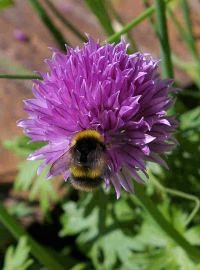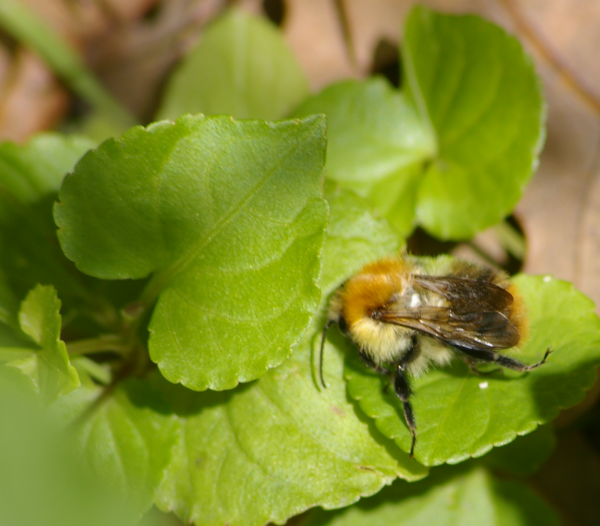Do Bees Sleep?
As one of the most studied creatures on the planet, it’s no surprise that scientists have asked many questions, including “do bees sleep?”
Do bees sleep?
The short answer to the first question is:
YES, according to
scientists, honey bees, bumble bees and solitary bees do sleep!
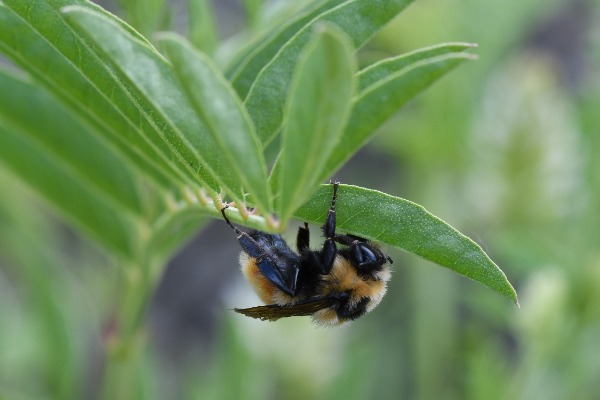 A male Bombus (bumble bee) sleeping on the underside of a leaf stem. Note relaxed antennae and wings.
A male Bombus (bumble bee) sleeping on the underside of a leaf stem. Note relaxed antennae and wings.5 Facts About Bees And Sleep
1. In general, females mostly sleep in the nest, (or hive in the case of honey bees). Male bees usually sleep outside the nest.
2. Some solitary bee species sleep by grasping the very end of a flower stem or twig only with their mandibles. They may keep perfectly still, until the following morning1.
3. Some solitary species return to the same sleeping spot each night1.
4. Male bumble bees usually sleep alone. However, males of different solitary species sleep singly, with others, or huddled together in groups inside flowers1.
5. Scientists have found that honey bees demonstrate some similar sleep states to those observed in humans and mammals2.
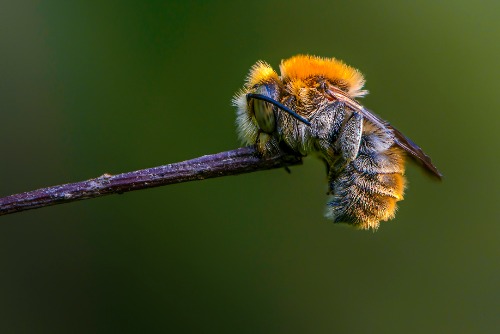 Male solitary species, possibly a type of mason bee, sleeping on the end of a twig.
Male solitary species, possibly a type of mason bee, sleeping on the end of a twig.Where do bees sleep?
It depends on the species.
Bumble bees
Males are usually seen sleeping or resting alone, perhaps in or on a flower, or grasping onto a plant leaf or stem, but sometimes they might be seen resting on a wall or simply on the ground.
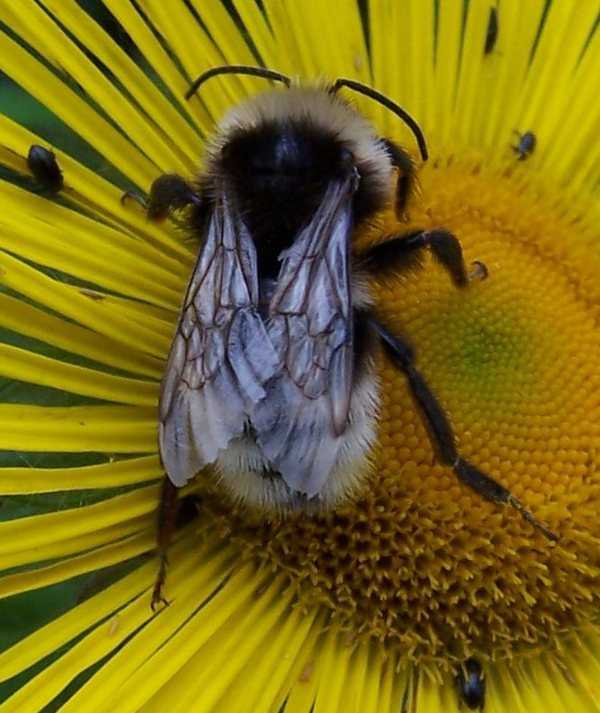 A male bumble bee species, Bombus barbutellus snoozing in a flower head
A male bumble bee species, Bombus barbutellus snoozing in a flower headSolitary species
Some species may rest singly, with other males (sometimes even of different species)1 or huddled together in groups1.
Amazingly, some species are able to grasp the end of a stem or twig with only their mandibles (jaws) and remain perfectly still until the following morning1.
Other solitary species may secure themselves by grasping hold of a stem or twig with their legs.
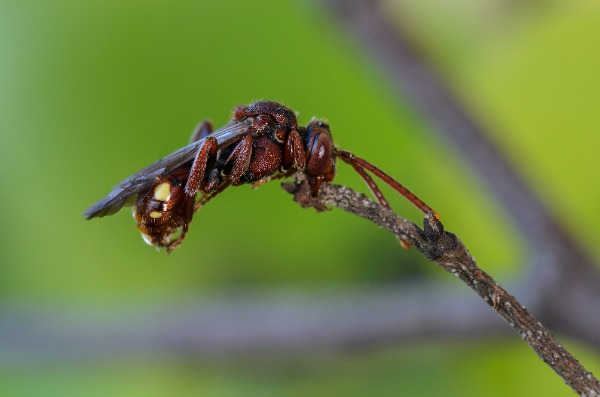 Male Nomad bee species sleeping on a twig. Grasping the twig only with his mandibles, he is able to remain perfectly still until the following morning.
Male Nomad bee species sleeping on a twig. Grasping the twig only with his mandibles, he is able to remain perfectly still until the following morning.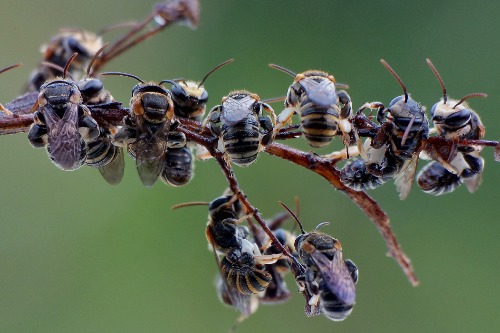 A group of resting solitary bee species, grasping onto a twig
A group of resting solitary bee species, grasping onto a twig
Honey bees
Honey bee colonies are superorganisms of many thousands of individuals, and the sleeping location within a nest or hive is partly dependent on the role of the individual within the colony. This topic is explored in greater detail below.
How do we know bees sleep and how do they sleep?
To answer this question, scientists say that it all depends on how we define ‘sleep’, and it seems that the state we refer to as ‘sleep’ in humans and mammals is also witnessed in bees.
This means that scientists studying honey bees in particular, have recorded physical conditions and postures akin to those witnessed in humans and mammals as they snooze2.
Sleep in honey bees has been found to be similar to mammals in the following ways, including:
1. Relaxed body posture, and not moving (immobile)
When a bee is in deep sleep, they have a distinct sleeping posture. Their antennae droop downwards,
the upper body (thorax) drops as does the tip of the abdomen (or tail), and the wings rest on the body.
Look closely, and you can see this in the images below. In the first image (A), the bee is alert: it has its wings up and extended, the whole body is off the ‘floor’, and antennae are facing forward. As the bee falls into a deep sleep in picture D, the antennae are drooping and the body and wings are relaxed.
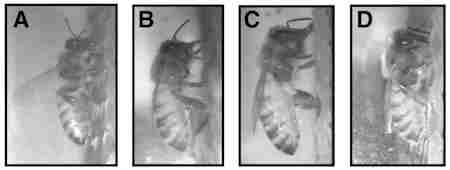 This image is from the scientific paper; ref: Eban-Rothschild, A. D. and Bloch, G. (2008). Differences in the sleep architecture of forager and young honeybees (Apis mellifera). J. Exp. Biol. 211,2408 -2416
This image is from the scientific paper; ref: Eban-Rothschild, A. D. and Bloch, G. (2008). Differences in the sleep architecture of forager and young honeybees (Apis mellifera). J. Exp. Biol. 211,2408 -2416
2. Drop in body temperature
Scientist also found that the body temperature of bees drops
when they sleep, which is also the case with humans.
3. The deeper the sleep, the harder it is to wake the sleeper!
It is even the case that the deeper a bee is sleeping,
the brighter the light needed to wake the bee2, which again, tends to be the same with humans.
4. Brain patterns
Finally, certain distinct patterns happen in
the bee brain when bees are sleeping.
When do bees sleep? Do bees sleep at night, or do they sleep during the day? At what time do bees sleep?
In bumble and solitary bees, most (apart from night-active species) will sleep at night, but you may catch individuals resting at various times of the day.
In honey bees, according to research2,6, there is some variance depending on the role within a
colony.
Foragers
Forager bees (the older worker bees
within the colony), are active during the day, but sleep at night back in the
nest or bee hive.
Foragers go through different sleep stages of light sleep and deeper sleep, and when awake they may be immobile for a while (not moving) or may groom to clean themselves.
Young workers
Very young worker bees (whose duties include cleaning the cells), also sleep in the hive or nest, but they have no fixed pattern of sleep as the foragers do.
Instead, they may be active during day or night, with periods of sleep (or naps) in between, spread out over a 24 hour period.
Scientists say they found no consistent differences in the amount of time that foragers and young workers spent sleeping.
However, scientists suggest that young bees may be in need of regular naps because their ongoing interaction with other bees tires them out.
Sleeping location
Honey
bee workers typically progress through a set of tasks, beginning with nest-based tasks, then ultimately
serving as the colony's foragers, thus foragers being the older worker bees in
the colony.
Scientists
investigated whether the role of the honey bee worker within the colony influenced where the bee sleeps6.
They found that older worker bees generally slept outside
cells, closer to the edge of the nest, in cooler areas, and away from uncapped
brood.
Younger worker bees generally slept inside cells and closer to the center of the nest. They spent more time asleep than awake when they were surrounded by uncapped brood.
Why do bees need sleep?
It seems bees need their sleep, because otherwise (just like humans), their performance is hampered.
Scientists studying honey bees found that bees deprived of sleep:
- were not able to waggle dance properly3, and
- have difficulty learning a new route home4,
- may also show signs of sleepiness during the day, for example by moving their antennae less5.
References
1. Wilson & Messinger-Carril; The Bees In Your Backyard, Princeton University Press 2016.
2. Rothschild, A. D. and Bloch, G. (2008). Differences in the sleep architecture of forager and young honeybees (Apis mellifera). J. Exp. Biol. 211,2408 -2416
3. Barrett A. Klein et al. (2010). Sleep deprivation impairs precision of waggle dance signalling in honey bees. PNAS – Proceedings of the National Academy of Sciences of the Unites States of America. vol. 107 no. 52 22705–22709, doi: 10.1073/pnas.1009439108.
4. Beyaert, L., Greggers, U. and Menzel, R. (2012). Honeybees consolidate navigation memory during sleep. J. Exp. Biol. 215, 3981-3988)
5. S Sauer, E Herrmann, W Kaiser, Sleep deprivation in honey bees. J Sleep Res 13, 145–152 (2004).
6. Klein BA, Stiegler M, Klein A, Tautz J (2014) Mapping Sleeping Bees within Their Nest: Spatial and Temporal Analysis of Worker Honey Bee Sleep. PLoS ONE 9(7): e102316. https://doi.org/10.1371/journal.pone.0102316
If you found this page helpful or interesting, I'd really be grateful if you would share it with others - if not this page, perhaps another, such as Gardening For Bees.
Thank you so much :) .
